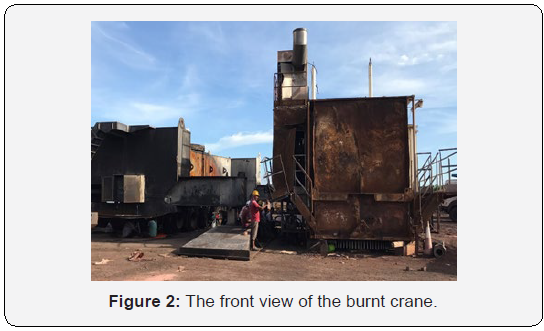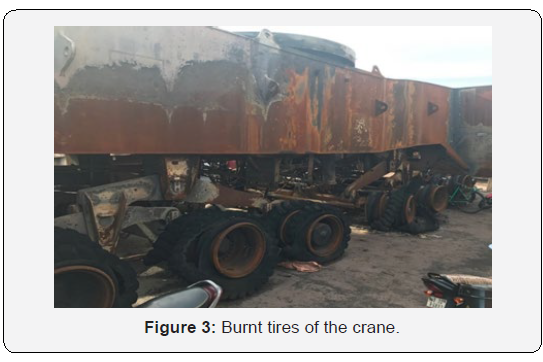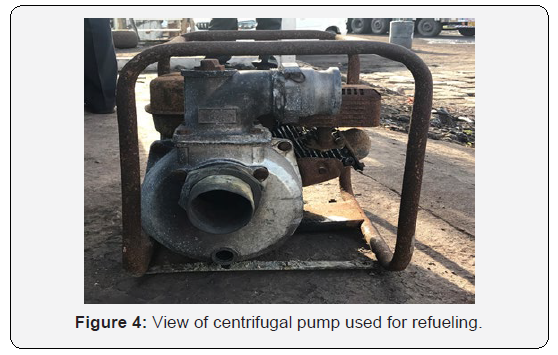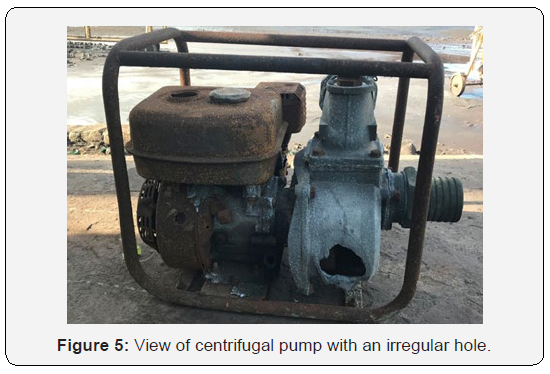Can Ignited Coking Coal Particles Falling on the Tires of a Crane Cause Fire?
TSN Murthy1*, E Mohan2 and G Pradeep Kumar3
1Former Joint Director, AP Forensic Science Laboratory, India
2 Research Scholar, Osmania University, India
3 Research Scholar, AP Forensic Science Laboratory, India
Submission:December 04, 2019; Published: December 11, 2019
*Corresponding author:TSN Murthy, Former Joint Director, AP Forensic Science Laboratory, HIG-61, Bharath Nagar Colony, Hyderabad 500018, India
How to cite this article:TSN Murthy, E Mohan, G Pradeep K. Can Ignited Coking Coal Particles Falling on the Tires of a Crane Cause Fire?. J Forensic Sci & Criminal Inves. 2019; 13(2): 555860. DOI: 10.19080/JFSCI.2019.13.555860.
Abstract
Mobile Harbor Crane used for loading and unloading commodities into ships was burnt in Haldia Port, India. Before the fire accident the crane was unloading coking, coal imported from Indonesia. Fire accident occurred after refueling the crane with HSD. It was presumed by the owners of the crane that the fire occurred due to self-ignition caused in the coking coal and the ignited coking coal particles travelling with the wind falling on the tires of the crane. As the insurance company was not satisfied, they sought the help of the authors to conduct forensic investigation and to determine cause of fire. It was found that the refueling was done from HSD oil tanker to the fuel tank of the crane which was about 20 feet from the ground level with the help a hydraulic pump. On a careful examination of the hydraulic pump it was found to have an irregular shape hole of 10cms in diameter with the edges of the hole averted. A detailed literature survey and information gathered during field visit; it was revealed that the inlet valve of the hose pipe used during refueling was closed without switching off the motor of the pump. This resulted in the churning of HSD in the impeller of the pump resulting in the increase of temperature. The highly volatile HSD vapor developed enormous pressure inside the pump resulting in the explosion of the casing of the pump. The burning diesel ejected with great force fell on the tires of the crane resulted in its catching fire.
Keywords: Mobile harbor crane; Centrifugal pump; HSD; Averted; Explosion; Coking coal
Abbreviations: HSD: High Speed Diesel; TED: Tennessee Eastman Division; BLEVE: Boiling Liquid Expanding Vapor Explosion
Introduction
There is a natural tendency for everyone to be impressed by the magnitude and violence of the fire itself and the degree of destruction that results from a large fire. In the case of insurance this tendency is aggravated by the fact that the damage due to fire is expected to be assessed and possibly pay the claim. For accurate investigation of fires, this preoccupation with the magnitude and results of the fire is unfortunate. The time of presumptions and assumptions is long gone. Only a successful forensic investigator with analytical approach with an understanding of numerous facets of fire, fuels, people and investigative procedures can only identify the cause of fire.
Case Report
In July 2019, a fire incident case was received from an insurance company for conducting forensic fire investigation to determine the cause of fire. Fire was reported to have occurred in a Mobile Harbor Crane of make Terex, year of construction 2016, which was unloading coking coal imported from Indonesia at Haldia Port, India (Figure 1). On the fateful day at about 08:15am the Safety & Electrical Engineer, technician & helper along with HSD fuel tanker went to the crane and started refueling with HSD as per scheduled programmed. The technical team completed the refueling by about 08:40am. A total of 4000 liters of HSD was filled. After refueling the technician and helper went to Storeroom to deposit tools and tackles required for process of refueling (Figure 2). After putting them in the Storeroom, they proceeded towards crane to gather rest of the tools and tackles. At that instant, they suddenly noticed fire near bottom part of the crane. On noticing fire, they alerted all concerned and informed the Crane Operator in walkie-talkie that there was a fire below and he must escape immediately. The duty ‘On Broad’ Supervisor immediately informed the Port Officials about the fire. The strong breeze fanned the fire and caused it to spread and burn very fiercely in a matter of minutes. This resulted in the entire crane being engulfed in flames and was severely damaged. Many workers gathered around to assist and help Crane Operator to escape from the cabin but in the course of trying to get away from the fire, the crane operator fell to the ground. He was immediately rushed to Hospital for emergency treatment where he succumbed to his injuries. A number of fire tenders reached and brought the fire under control by about 12:40pm (Figure 3).



Procedure for Refueling
Once the HSD fuel tanker arrives, the team (3 persons) will reach the spot and inform the Crane Operator through walkietalkie about the readiness for refueling. The Crane Operator will put the crane in ‘stand by’ position. One of team members will take the dip measurement in the main tank of the crane to find the quantity of HSD in the tank. Suction hose pipe is connected from HSD fuel tanker to pump-motor and delivery hose pipe is connected from pump-motor to crane diesel engine main tank. The delivery hose pipe is tied to the crane railing in front of PLC room to stop any movement due to wind. After starting the pump, the suction valve is opened for delivery of HSD. Final measurement of diesel will be taken by technician or helper. Once the tank is full, pump will be stopped, the delivery hose pipe will be taken out from main tank and moved down to ground using a rope. The balance diesel in the hose pipe is taken out into a bucket or container and will be moved to Storeroom along with the accessories used for refueling. After refueling, the crane will start as per technician’s command.
Observations & Findings
The pump used for refueling the crane is a centrifugal pump called in the local market as “Petrol start, kerosene run pump”. As the name suggests, the pump starts with petrol and runs with kerosene. It became obsolete now and only petrol operated water pumps are available in the market. On a thorough examination, the casing of centrifugal pump was found to have an irregular hole of about 10cms in diameter along with a crack that propagated to the top of the pump. Further examinations of the edges of the hole which are more pronounced in the bottom side are found to be from inside out (everted). This shows that the hole formed was not due to striking with a stone or similar object/objects but must be due to some violent explosion/ burst that must have occurred inside the pump. View of the hole with its edges averted Several explosions/bursts of centrifugal pumps are reported in the literature 1-3. In some cases, these have resulted in the fatalities, severe burns and damage to the property. In the publication, “Rise of the machines” Centrifugal Pump Explosions [1] mentions that, when a centrifugal pump continues to operate with closed valves, a certain percent of the motor power is transferred to the fluid in the casing as heat energy. Eventually the fluid heats up to boiling temperature and turns to vapor. The pump then effectively becomes a boiler (Figure 4).

The pressure due to the superheated vapor then reaches a point where it exceeds the strength of the casing or the casing bolts. When this point is reached, the pump either explodes or bursts under pressure. In the publication, “Case histories of pump explosions while running isolated” [2] mentions that, standard industrial centrifugal pumps that isolate process material (i.e. “deadheaded” with both suction and discharge valves closed) inside the pump casing can explode catastrophically if the pump is inadvertently started and left running (Figure 5 & 6). Case histories and lessons learned at Tennessee Eastman Division (TED) involved in pump explosions while running isolated. Case histories involve both combustible and non‐combustible process streams where the pump was inadvertently started and allowed to run isolated until the process material heated up and built enough pressure to rupture the pump housing creating a BLEVE (Boiling Liquid Expanding Vapor Explosion). In KETO Global Pump Solutions [3], Green Paper, Centrifugal Pump Explosions 2017 “Centrifugal Pump Explosions” under “Operating parameters that cause explosion”, 3, mentions that, if a pump is dead headed the impeller spins in the volute, causing the temperature of the liquid contained to increase over a period of time. If the pump suction and discharge lines are closed, there is nowhere for the liquid to go. If the impeller continues to be spun the liquid temperature increases until steam is formed. Unless the steam is relieved by some means, or the pump is stopped before the casing burst pressure is reached, a pump explosion will result.


Results & Discussion
In the above-mentioned papers, the centrifugal pump explosions occurred when the pump was pumping water. The type of centrifugal pump used for refueling the crane was also meant for pumping water only and certainly should not be used for pumping flammable low boiling point liquids such as High- Speed Diesel (HSD), wherein, the vapor expansion is faster leading to severe explosion with fire. During refueling, after the crane tank was filled, the inlet valve to the crane tank was closed to avoid reverse flow but the motor was not stopped by mistake/carelessness and must have been still running, trying to pump HSD. The temperature of HSD in the impeller increased due to churning of HSD on the impeller blades and ignited HSD. Being highly volatile the heated HSD vapor developed enormous pressure inside the pump resulting in its explosion. Because of the huge pressure, the burning ejected HSD with great force spread the fire all along to the bottom part of the crane. The tires of the crane caught fire which subsequently spread to the hydraulic system located just above the tires which contained copious quantity of hydraulic oil further escalating the flames. Due to high wind prevailing on that day, the coking coal particles deposited/settled on the tires, on the body of crane acted as fire accelerants, spreading the flames rapidly. The version of the owners of the crane was that the fire was caused due to coking coal catching fire due to self-ignition, moving with the gusty winds and falling on the tries of the crane is ruled out, as the fire in coal dust was instantaneous & momentary and could not sustain for long periods. Further, gusty winds themselves could extinguish the fire in the coal particles, as they are very thin. The coal only burns in air and does not produce flame as it does not vaporize.
Conclusion
It was concluded that the fire incident was due to closing of the inlet valve of the crane tank, with pump running the temperature of HSD in the impeller of the pump increased igniting HSD. The ignited HSD developed enormous pressure inside pump resulting in the explosion of casing. The burning HSD ejected with great force on reaching the bottom part of crane resulted in the tires catching fire. The root cause of the fire incident was due to using a pump not meant for refueling HSD and negligence on the part of the concerned in running the pump after closing the valve.
References
- Brian PO’ Connor (2006) Anglo American Platinum Publications, Rise of Machines, Centrifugal Pump explosions.
- Douglas S Giles, Peter NLodal (2004) American Institute of Chemical Engineers, Case histories of pump explodes while running isolated.
- KETO Global Pump Solutions (2017) Green Paper, Centrifugal Pump Explosions.






























